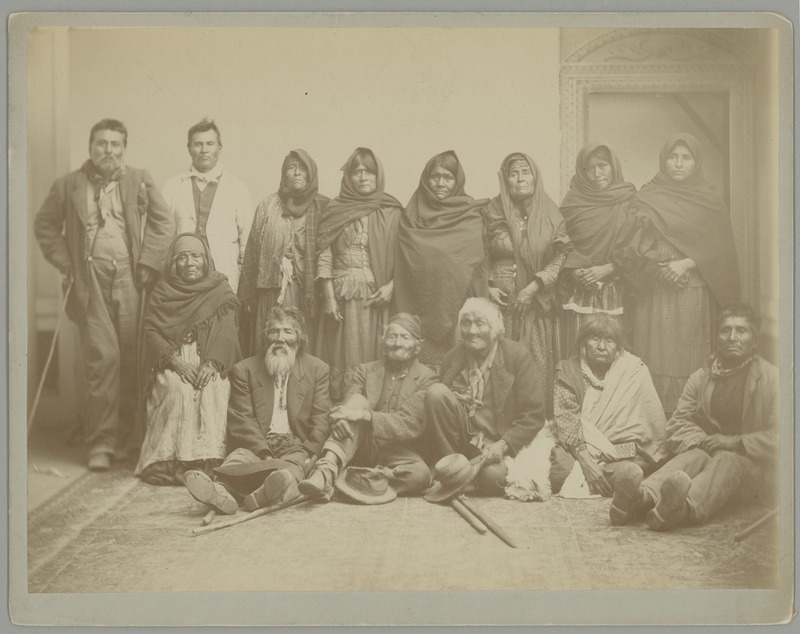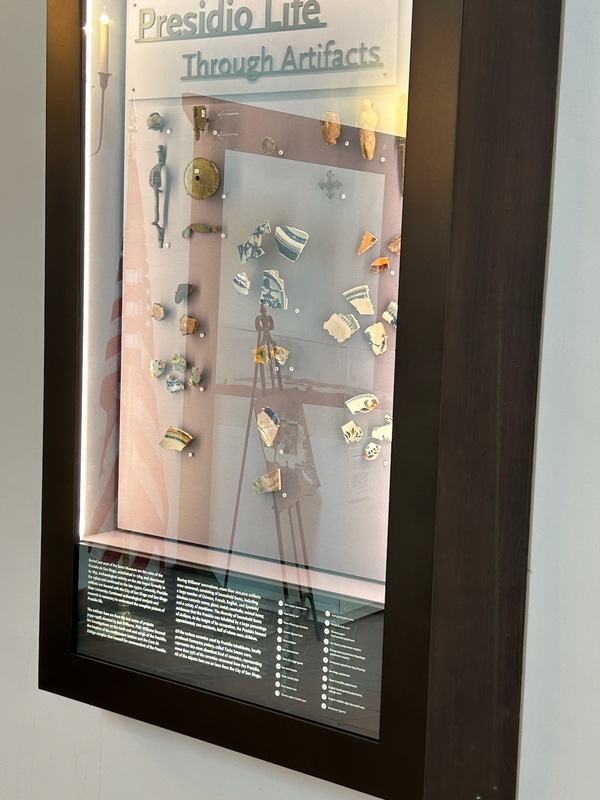Kumeyaay Voices (1769-Present)
The Kumeyaay point of view in regards to the Presidio is one that started out simple enough, yet very quickly turned violent and slowly transitioned into a losing effort as a whole in San Diego for the Native Americans. In 1769, when the first missionaries and Spanish soldiers arrived and established the Presidio, interactions were mixed. At first, the local Kumeyaay tribes saw them as merely strange, hairy men who lacked manners to their customs. Over time, however, they realized that the tribes and Spaniards could and actively would trade with them. As noted by Father Serra himself, the Spanish “wished to give them something to eat, they would generally answer that they did not want that but that they would like some clothing, and only for articles of this sort would they make exchanges of fish and other things with the soldiers and muleteers.” [1] It soon became apparent though that, while the missionaries would interact with them in kindness, the Spanish soldiers chose more brutal methods. They would regularly steal from the Kumeyaay and most egregiously, rape their women. This in turn led to the distrust of all Spaniards. As Florence Shipek describes below, they eventually came to dislike the missionaries goal of converting its people toward Christianity and instead prepared itself for attack at any moment:
“Thus the Kumeyaay people were independent individuals, subject to orders from no one, and able to move freely through Kumeyaay territory visiting relatives… Their reaction to attempts of the Franciscans to order them to work or remain at the mission is well known. They were constantly the most recalcitrant of those baptized. The Kumeyaay tribal chief Kuchut Kwataay shifted their lookout system which watched for possible raids from neighboring tribes to watching the Spanish at the Mission and Presidio, in order to warn inland bands whenever any Spanish military group marched inland.” [2]
The tension between the Kumeyaay and the inhabitants at the Presidio would eventually come to a head. An attack on the Presidio was eventually launched to attempt to drive out the Spanish, leading to the killing of Father Luis Jayme. After this revolt, the Spanish missionaries moved location 6 miles east, with an uneasy trading relationship continuing between both sides for several decades.
During the Mexican Period of the Presidio, the Kumeyaay faired no better. When the missions became secularized, the Kumeyaay did not have the freedom that they hoped would be granted after the Spanish left Jennifer Luksic and Nik Kendziorski explain the situation of the Kumeyaay in 1833:
“In 1833 the Mexican government secularized the missions, with curates replacing priests, then divided the land into large rancheros for themselves and other members of the emerging ruling class. The land management practices brought to San Diego by the Spanish had evolved over the years and under Mexican rule became one dominated by cattle ranching in response to the hide trade. The Kumeyaay population, which had been assimilated into mission life, was cast out by the government.17 In their desperate search for protection and a livelihood, many of the Indians became near slaves for the wealthy Mexican Rancheros.” [3]
As California’s transition from Mexico to the United States solidified, Kumeyaay treatment remained the same. Native American peoples continued to be pushed further east in San Diego, creating problems of food scarcity and livable land. Ultimately, it was the US government and the California governor in 1903 that led to the same story the Native peoples were used to: forced relocation in order to establish a reservoir for the growing citizens in San Diego. [4] Worse still, any acknowledgement of the Kumeyaay tribe and their existence in the region was largely overlooked during prestigious celebrations such as the Panama-California exposition and even in places such as the museums and architecture in Old Town.
This trend, thankfully, eventually ended. At the 250th anniversary celebration in 2019 of not only the Presidio’s founding, but also San Diego itself, Kumeyaay presence was finally felt and shown. A raising of the Kumeyaay flag alongside songs and traditions of their people being celebrated, the collaboration between the existing tribe and the Museum on the site of the Presidio showcased the progress being made to acknowledge the Native peoples that came before. [5]
[1] Francisco Palou, George Walton James, and C. Scott Williams, Francisco Palou's Life and Apostolic Labors of the Venerable Father Junipero Serra, trans. C. Scott Williams (Pasadena: G.W. James, 1913), 76.
[2] Florence C. Shipek, “California Indian Reactions to the Franciscans,” The Americas 41, no. 4 (1985): 487.
[3] Jennifer Luksic and Nik Kendziorski, "The Use of Presidio Hill" The Journal of San Diego History 45, no. 3 (1999): https://sandiegohistory.org/journal/1999/july/presidio-2/#:~:text=During%20the%20Mexican%2DAmerican%20War,and%20named%20it%20Fort%20Stockton.
[4] Damon B. Akins and William J. Bauer, “Beach Encounters: Indigenous People and the Age of Exploration, 1540–1769,” In We Are the Land: A History of Native California (Berkeley: University of California Press, 2021), 62.
[5] Peterson, Karla. “San Diego celebrates 250 years with an overdue inclusive ceremony.” July 19, 2019. San Diego Union-Tribune. https://www.baltimoresun.com/column-san-diego-celebrates-250-years-with-an-inclusive-ceremony-story.html


